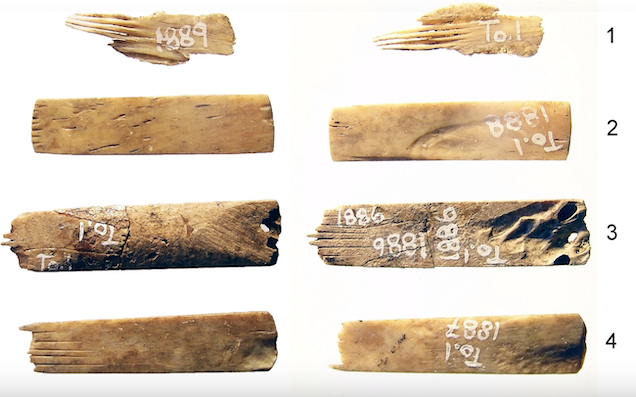
In an extraordinarily metal development, researchers have found human bones in what is believed to be the world’s oldest complete tattooing kit.
The tools, found on Tonga‘s main island, Tongatapu, were found to be around 2700 years old by radiocarbon dating and are almost identical to the traditional tattooing tools still in use in the Pacific. While older tattooing tools have been found elsewhere, the inclusion of an inkwell (documented in 1963 but currently missing) leads researchers from Griffith University to believe the set to be the oldest complete set in the world.
[jwplayer gvkTjsCy]
Dr Michelle Langley from Griffith’s Australian Research Centre for Human Evolution says that these finds are not at all common. “The discovery of early tattooing implements is exceptionally rare,” Dr Langley said. “So, to find an entire kit is phenomenal. We very rarely find a whole kit of any type of tools in the archaeological record. These artefacts show that the modern tattooist toolkit — one-piece narrow combs, haft, mallet, carbon pigment, mortar, pestle, and ink-holding vessel — were in use 2700 years ago in West Polynesia.
“The kit most likely belonged to one tattoo artist. One tool was broken and it looks like it was being repaired, so perhaps the kit was accidentally left behind or was too broken to bother salvaging. Perhaps the tattooist was given a new set.
“The actual tool itself – the comb shape and the way it’s used – hasn’t changed much, and that’s why this find is so interesting. These ancient tools continue to be used today.”
While the kit was found back in 1963 (and very nearly destroyed in the 2003 Canberra bushfires), Langley and Geoffrey Clark from the Australian National University School of Culture, History & Language were the first to minutely study and date the kit, publishing their findings in the The Journal of Island and Coastal Archaeology.
One of their major discoveries is the origin of the bones used to make the tools. Two of the bones comes from seabirds, with the remaining two belonging to larger mammals, leading them to one conclusion, according to Langley: “As there were no other mammals of that size on the island at the time, and human bone is known to be a preferred material for making tattooing combs, we believe they are most likely made from human bone.”
Under microscopic analysis, traces of the original ink was found still embedded in the bone, which is cool as hell.
You can watch Langley talk about it below:



